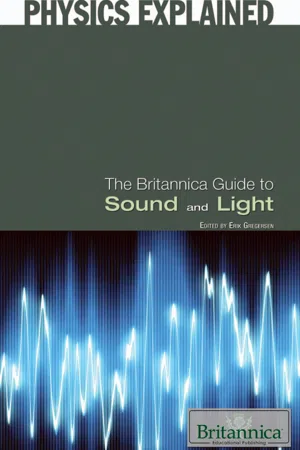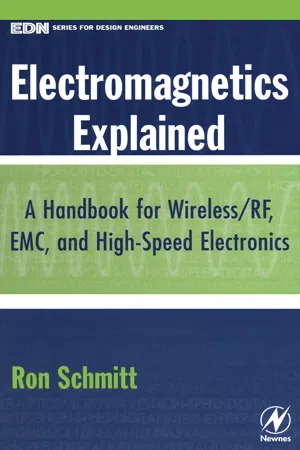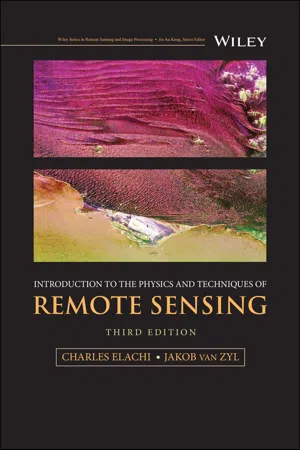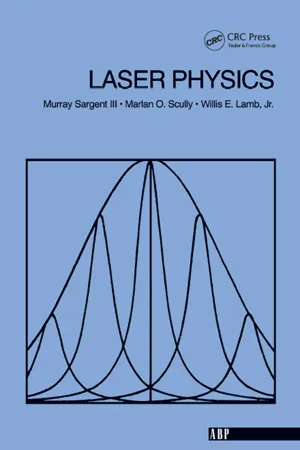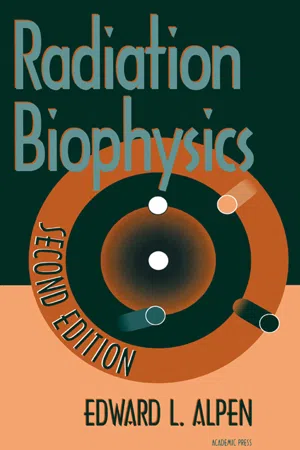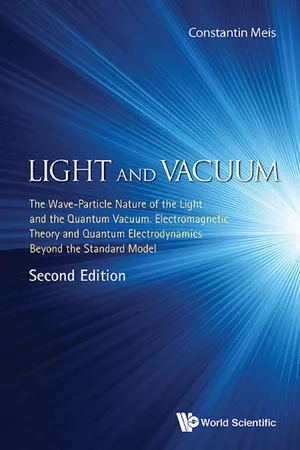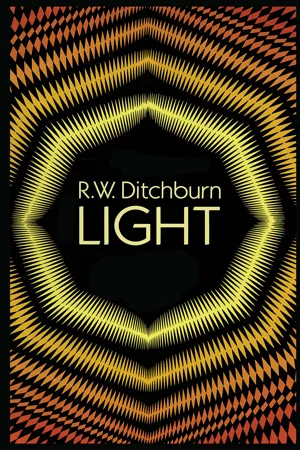Physics
Electromagnetic Radiation and Quantum Phenomena
Electromagnetic radiation refers to the energy that is transmitted through space in the form of electromagnetic waves, such as light, radio waves, and X-rays. Quantum phenomena, on the other hand, are the behaviors and interactions of particles at the quantum level, where classical physics principles no longer apply. These phenomena are described by quantum mechanics, a fundamental theory in physics that governs the behavior of matter and energy at the smallest scales.
Written by Perlego with AI-assistance
Related key terms
Related key terms
1 of 4
Related key terms
1 of 3
12 Key excerpts on "Electromagnetic Radiation and Quantum Phenomena"
- eBook - ePub
- Britannica Educational Publishing, Erik Gregersen(Authors)
- 2010(Publication Date)
- Britannica Educational Publishing(Publisher)
CHAPTER 5 ELECTROMAGNETIC RADIATIONI n terms of classical theory, electromagnetic radiation is the flow of energy at the universal speed of light through free space or through a material medium in the form of the electric and magnetic fields that make up electromagnetic waves such as radio waves, visible light, and gamma rays. In such a wave, time-varying electric and magnetic fields are mutually linked with each other at right angles and perpendicular to the direction of motion. An electromagnetic wave is characterized by its intensity and the frequency ν of the time variation of the electric and magnetic fields.GENERAL CONSIDERATIONS
In terms of the modern quantum theory, electromagnetic radiation is the flow of photons (also called light quanta) through space. Photons are packets of energy h ν that always move with the universal speed of light. The symbol h is Planck’s constant, while the value of ν is the same as that of the frequency of the electromagnetic wave of classical theory. Photons having the same energy h ν are all alike, and their number density corresponds to the intensity of the radiation. Electromagnetic radiation exhibits a multitude of phenomena as it interacts with charged particles in atoms, molecules, and larger objects of matter. These phenomena as well as the ways in which electromagnetic radiation is created and observed, the manner in which such radiation occurs in nature, and its technological uses depend on its frequency ν. The spectrum of frequencies of electromagnetic radiation extends from very low values over the range of radio waves, television waves, and microwaves to visible light and beyond to the substantially higher values of ultraviolet light, X-rays, and gamma rays.OCCURRENCE AND IMPORTANCEClose to 0.01 percent of the mass/energy of the entire universe occurs in the form of electromagnetic radiation. All human life is immersed in it and modern communications technology and medical services are particularly dependent on one or another of its forms. In fact, all living things on Earth depend on the electromagnetic radiation received from the Sun and on the transformation of solar energy by photosynthesis into plant life or by biosynthesis into zooplankton, the basic step in the food chain in oceans. The eyes of many animals, including those of humans, are adapted to be sensitive to and hence to see the most abundant part of the Sun’s electromagnetic radiation—namely, light, which comprises the visible portion of its wide range of frequencies. Green plants also have high sensitivity to the maximum intensity of solar electromagnetic radiation, which is absorbed by a substance called chlorophyll that is essential for plant growth via photosynthesis. - eBook - ePub
- Gerald D. Mahan(Author)
- 2008(Publication Date)
- Princeton University Press(Publisher)
8 Electromagnetic RadiationElectromagnetic radiation is composed of elementary particles called photons. They are massless, chargeless, and have spin -1. They have a momentum , energy cp , and a frequency . The light has two choices of polarization, which are given the label λ (λ = 1,2). The frequency is the same one that is associated with an oscillating electric field. The correspondence between the classical electric field and the quantum picture of photons is that the intensity of light is proportional to the number of photons nkλ. For an electric field of classical amplitude E 0 , wave vector k, and frequency ω = ck , the energy flux is given by the Poynting vector to bewhere Ω is the volume of the box. In the photon picture, the particles have an energy flux given by the product of their velocity c , the energy , and the density nkλ/Ω. The refractive indexnris assumed to be unity. The speed of light c should be replaced by c /nrwhennrdiffers from one. From the above equation, we deduce a quantum mechanical definition of electric field:The main difference between the classical and quantum picture is that in classical physics the electric field E 0 can have any value. In quantum physics the number of quanta nkλin volume Ω must be an integer, so that the light intensity is not continuous but comes in multiples of . This difference is unobservable on a macroscopic basis where the number of quanta nkλis very large. It can be quite noticable for very small fields, where nkλis a small integer.The photon picture applies to electromagnetic radiation of all freqencies, from the microwave to hard x-rays. The only difference is the wavelength. The Hamiltonian for photons interacting with charge particles is derived in the next section.8.1 Quantization of the Field
Electromagnetic theory is based on Maxwell’s equations, which areHere ρ and j - Maged Marghany(Author)
- 2019(Publication Date)
- Gulf Professional Publishing(Publisher)
Chapter 3Quantization of Maxwell’s equations
Abstract
It is impossible to talk about Maxwell’s equations without relating them to quantum mechanics. This chapter is devoted to understanding Maxwell’s equations from the point of view of the quantum concept. To this end, conventional quantum radiation and photoelectric concepts are considered. It is important to implement the Dirac equation to understand the mechanism of electromagnetic waves through Maxwell’s equations. In addition, wave-particle duality must be taken into account to investigate the behavior of electromagnetic waves. It is important to investigate the mechanism of electromagnetic wave scattering using the Feynman diagram.Keywords
Quantum mechanics; Photoelectric concepts; Feynman diagram; Wave-particle duality; Photon energy; Quantum theory3.1 Quantum radiation
Why is it critical to understand quantum theory to comprehend remote sensing/electromagnetic waves? It is a difficult question to answer. Quantum theories play a remarkable role in comprehending the mechanisms and characteristics of remote sensing technology. This is accomplished through the exploitation of both optical and microwave remote sensing technologies. The main aim of this chapter is to clarify how quantum theories are used to investigate Maxwell’s equations. Therefore, you need to understand that the electromagnetic (EM) spectrum; EM radiation; and light, radar, and radiowaves are based on quantum theories.The main physical characteristic of EM waves, including light, is a dual nature. In other words, EM waves act like waves, and produce interference and diffraction impacts when propagating through space. On the contrary, the interaction of EM beams with atoms and molecules cause a stream of energy corpuscles, which is known as photons or light–quanta.The wave theory of EM radiation is adopted based on the concept of particle waves. Consequently, EM can behave like a wave or a particle, whereas a “particle” of light is called a photon. In other words, the deficiency of the wave theory preceded a revival of the idea that EM radiation might better be thought of as particles, dubbed photons. In this sense, a photon is defined as a discrete packet of energy associated with EM radiation (light) (Fig. 3.1 ). The energy of a photon can mathematically be written as [1]- eBook - ePub
Electromagnetics Explained
A Handbook for Wireless/ RF, EMC, and High-Speed Electronics
- Ron Schmitt(Author)
- 2002(Publication Date)
- Newnes(Publisher)
1 INTRODUCTION AND SURVEY OF THE ELECTROMAGNETIC SPECTRUMHow does electromagnetic theory tie together such broad phenomena as electronics, radio waves, and light? Explaining this question in the context of electronics design is the main goal of this book. The basic philosophy of this book is that by developing an understanding of the fundamental physics, you can develop an intuitive feel for how electromagnetic phenomena occur. Learning the physical foundations serves to build the confidence and skills to tackle real-world problems, whether you are an engineer, technician, or physicist.The many facets of electromagnetics are due to how waves behave at different frequencies and how materials react in different ways to waves of different frequency. Quantum physics states that electromagnetic waves are composed of packets of energy called photons. At higher frequencies each photon has more energy. Photons of infrared, visible light, and higher frequencies have enough energy to affect the vibrational and rotational states of molecules and the electrons in orbit of atoms in the material. Photons of radio waves do not have enough energy to affect the bound electrons in a material. Furthermore, at low frequencies, when the wavelengths of the EM waves are very long compared to the dimensions of the circuits we are using, we can make many approximations leaving out many details. These low-frequency approximations give us the familiar world of basic circuit theory.THE NEED FOR ELECTROMAGNETICS
So why would an electrical engineer need to know all this theory? There are many reasons why any and all electrical engineers need to understand electromagnetics. Electromagnetics is necessary for achieving electromagnetic compatibility of products, for understanding high-speed digital electronics, RF, and wireless, and for optical computer networking. - Andreas Braeuer(Author)
- 2015(Publication Date)
- Elsevier(Publisher)
Fig. 2.1 .Figure 2.1 Classification of different interaction mechanisms of matter and electromagnetic radiation.2.1. Properties of electromagnetic radiation and photons
Here the basics about electromagnetic radiation are provided, which are relevant for understanding the interaction mechanisms of matter and electromagnetic radiation addressed in this book. In detail I describe for a harmonic wave, which features a sinusoidal profile, the wavelength, the phase, the frequency, the wavenumber and the polarisation. We will see in the chapters that follow that under certain circumstances the interpretation of electromagnetic radiation in terms of photons is more elegant than in terms of harmonic waves. Therefore Section 2.1.4 provides the energy and the momentum of photons.2.1.1. Equation of a Harmonic Wave
The wave functionΨ ( x , t ) = A ⋅ sin ( k ( x ± c t ) ) = A ⋅ sin ( k x ± ω t )(2.1)of a wave with a sinusoidal profile propagating with time t along the x -direction with a speed of propagation c is shown in Fig. 2.2 . A is the amplitude of the wave, which is the maximum value of the magnitudeΨ ( x , t )- eBook - ePub
From Atoms to Higgs Bosons
Voyages in Quasi-Spacetime
- Chary Rangacharyulu, Christopher J. A. Polachic, Chary Rangacharyulu, Christopher J. A. Polachic(Authors)
- 2019(Publication Date)
- Jenny Stanford Publishing(Publisher)
2 Ole Rømer (1644–1710) was a Danish scientist of multifaceted talents. Over 8 years, he worked at a solution to the important problem of determining a ship’s longitude when out of sight of land.3 The common term “electromagnetic radiation” may lead to a confusion that all radiation has some electromagnetic properties. It simply means that this type of radiation arises from sources that have electric and magnetic properties. They carry energy, linear momentum and angular momentum, and information about the changes in properties of the emitting and absorbing bodies.4 Standing waves originate when two or more waves are superposed as they travel in the same elastic medium. The waves are in motion through the medium, but the effect of the superposition is such that they seem to be standing still. Standing wave phenomena are associated with many everyday phenomena, including the sounds made by musical instruments.5 Wilhelm Wien (1864–1928) was a German physicist; Josef Stefan (1835–1893) and Ludwig Boltzmann (1844–1906) were both Austrian physicists. Boltzmann’s contributions extend beyond that of blackbody radiation. A fundamental constant, known as the Boltzmann constant , is at the heart of the correspondence between energy and the concept of temperature.6 The result is from the kinetic theory of gases where the average kinetic energy of a molecule is given by k B T . In the blackbody radiation theory, radiation is also assigned the same energy per wave.7 These theoretical treatments gave rise to a parameter called Wien’s constant, as well as the Rayleigh–Jeans constant, the two parameters of importance in the cryogenics industry.8 We should note, however, that these statements are valid for photon beams of low intensities. It has been repeatedly verified that one can accelerate electrons and ions to very high energies with high-power lasers of low-energy photons. See, for example, Victor Malka, https://accelconf.web.cern.ch/accelconf/IPAC2013/papers/moybb101.pdf (accessed May 2018).9 - Charles Elachi, Jakob J. van Zyl(Authors)
- 2021(Publication Date)
- Wiley(Publisher)
2 Nature and Properties of Electromagnetic Waves2.1 Fundamental Properties of Electromagnetic Waves
Electromagnetic energy is the means by which information is transmitted from an object to the sensor. Information could be encoded in the frequency content, intensity, or polarization of the electromagnetic wave. The information is propagated by electromagnetic radiation at the velocity of light from the source directly through free space, or indirectly by reflection, scattering, and reradiation to the sensor. The interaction of electromagnetic waves with natural surfaces and atmospheres is strongly dependent on the frequency of the waves. Waves in different spectral bands tend to excite different interaction mechanisms such as electronic, molecular, or conductive mechanisms.2.1.1 Electromagnetic Spectrum
The electromagnetic spectrum is divided into a number of spectral regions. For the purpose of this text, we use the classification illustrated in Figure 2.1 .The radio band covers the region of wavelengths longer than 10 cm (frequency less than 3 GHz). This region is used by active radio sensors such as imaging radars, altimeters, and sounders, and, to a lesser extent, passive radiometers.The microwave band covers the neighboring region, down to a wavelength of 1 mm (300 GHz frequency). In this region, most of the interactions are governed by molecular rotation, particularly at the shorter wavelengths. This region is mostly used by microwave radiometers/spectrometers and radar systems.The infrared band covers the spectral region from 1 mm to 0.7 μm. This region is sometimes subdivided into subregions called submillimeter, far infrared, thermal infrared, and near infrared. In this region, molecular rotation and vibration play an important role. Imagers, spectrometers, radiometers, polarimeters, and lasers are used in this region for remote sensing. The same is true in the neighboring region, the visible region (0.7–0.4 μm) where electronic energy levels start to play a key role.- eBook - ePub
- Murray, Iii Sargent(Authors)
- 2018(Publication Date)
- CRC Press(Publisher)
XIV QUANTUM THEORY OF RADIATION 14. Quantum Theory of RadiationIn our preceding treatments of the interaction of radiation with matter, we assumed that the electric field is classical. In most cases, this assumption is validated by experiment. There are several instances, however, for which a classical field fails to give experimentally observed results, whereas a quantized field succeeds. This is true, for example, of spontaneous emission, a phenomenon which was described phenomenologically in our earlier work (see Chaps. 2 and 7 ). Another case involves the2 sand1 22 pstates in the hydrogen atom, which are predicted to have the same energy not only by the simple theory of Chap. 1 , but also by the more sophisticated Dirac theory. In both cases, a classical electric field was assumed. Experimentally, the two levels differ by approximately the Lamb shift, 1057 MHz. A fully quantized treatment of the field and atom system gives impressive agreement with the experimentally observed shift. Derivation of the fluctuations in intensity of a laser near threshold requires the quantum theory of radiation. In addition there are other problems for which the concept of a “particle,” the photon, is either necessary or convenient. Despite a popular impression to the contrary, however the explanation of the photoelectric effect is not one of these (see Prob. 2-10).1 2Believing, then, that a quantized field approach leads to physically observed results, we benefit from understanding the method both in evaluating the semiclassical theory and in deriving results beyond the scope of the latter. In Sec. 14-1 we show how the electric and magnetic fields of a single-mode, cavity resonator correspond to the position and momentum of a simple harmonic oscillator and thus can be quantized along the lines mentioned in Chap. 1. This leads naturally to a discussion of the photon, the quantum of the electromagnetic field. The treatment is then generalized to a multimode (nonmonochromatic) field in Sec. 14-2 . In Sec. 14-3 we discuss the atom-field interaction in the electric-dipole approximation and give a fully quantum-mechanical treatment of Rabi flopping. This phenomenon was treated in the semiclassical approximation in Sec. 2-4 . In Sec. 14-4 the Weisskopf-Wigner theory of spontaneous emission is presented. This theory justifies the inclusion of phenomenological decay rates γa and γb in the Schrödinger equations for the atomic probability amplitudes of Sec. 2-3 . In Appendix G - eBook - ePub
- Edward L. Alpen(Author)
- 1997(Publication Date)
- Academic Press(Publisher)
E , can then be described as(2.3b)QUANTUM THEORY OF ELECTROMAGNETIC RADIATION
As suggested, Maxwell’s classical theory of electromagnetism proposed that energy is emitted in the form of electromagnetic waves when an electric charge is accelerated. Also a charge undergoing simple harmonic motion will generate electromagnetic waves with the same frequency as the moving charge. Planck’s formulation, a radical and anti-intuitive proposal for its time, suggests that the energy emitted by an oscillator is determined by its frequency, v , a constant, h , and an integer number, n . It says that the oscillator can have only a number of quantized energy steps determined by the value of n . The oscillators do not radiate energy in a continuum, but only in quantized steps determined by the quantum number n . Much later developments revealed a minor discrepancy in Planck’s formula, which is now written as(2.4)Planck’s constant, h , is equal to 6.63 × 10−34 J s (4.14 × 10−15 eV s).The concept of the quantized nature of an oscillator offended many of Planck’s colleagues of the time. They could indeed observe that the energy of, for example, an oscillating spring system or an electrical resistance-capacitance-inductance circuit seemed to have any value in a continuum, thus violating the “generality principle” of physical law. Readers can prove for themselves that there is indeed no conflict with the observed behavior of oscillators in macrosystems. The quantum numbers of such oscillators will be enormous, and the “jumps” in energy will not be apparent (see Problem 1 at the end of this chapter). Planck presented his concepts to the Berlin Physical Society on December 14, 1900. At that time his concept of the radiation emitted was that of an electromagnetic wave. It remained for Einstein to define the concept of the photon, a packet of energy that has both the wave properties of electromagnetic radiation, which are necessary for the understanding of diffraction and refraction, and the properties of a “bundle of energy,” the energy of which is defined by Planck’s law. - eBook - ePub
Light And Vacuum: The Wave-particle Nature Of The Light And The Quantum Vacuum. Electromagnetic Theory And Quantum Electrodynamics Beyond The Standard Model (Second Edition)
The Wave–Particle Nature of the Light and the Quantum Vacuum. Electromagnetic Theory and Quantum Electrodynamics Beyond the Standard Model
- Constantin Meis(Author)
- 2017(Publication Date)
- WSPC(Publisher)
Chapter 4
From Electromagnetic Waves to Quantum Electrodynamics
4.1.Elements of Quantum Mechanics
•Blackbody radiation and the ultraviolet catastropheThe study of the properties of radiation emitted by hot bodies was the starting point for the development of the quantum theory at the end of the 19th and the beginning of the 20th centuries. The experimental evidence has shown that the spectral distribution, in other words the distribution of the wavelengths of the radiation, as well as the total energy radiated depend directly on the temperature of the body.The number of standing electromagnetic waves, i.e., the number of modes, per unit volume and unit frequency within a cavity is given by the expression (3.5.43 ). It can be shown that for a sufficiently big cavity this expression holds whatever its shape. Considering, the electromagnetic waves to be in thermal equilibrium at temperature T with the walls of the cavity, the probability p(E) that a mode has an energy E included between E + dE, is obtained in classical theory bywhere kB is Boltzmann’s constant.The mean energy of a mode is thusConsequently, all the modes have the same mean energy, independent of the frequency. Using (3.5.43 ), the energy per unit volume of the cavity at temperature T and per unit frequency writesThe last expression is known historically as the Rayleigh-Jeans energy density which fails to describe the experimentally observed results at high frequencies, often called the “ultraviolet catastrophe”, while giving an infinite total energy per unit volume of the cavity when summing up along all the frequenciesIn order to resolve this problem, Max Planck introduced the original idea that the cavity walls are composed of local oscillators, each one being capable of absorbing and emitting discrete quantities of electromagnetic energy nhν, where n is an integer and h - eBook - ePub
- R. W. Ditchburn(Author)
- 2013(Publication Date)
- Dover Publications(Publisher)
CHAPTER XVIII
Quantum Theory of Radiation
18.1. Relation between Theory of Radiation and Theory of Atomic Structure.In the preceding chapter we saw that the quantum theory began as a theory of the interaction between radiation and matter, but that quantum principles came to be applied both to the radiation itself, in the Einstein theory of photons, and to the atoms in Bohr’s theory of stationary states. The connecting link, Bohr’s frequency condition [equation 17(7) ], is a direct application of the law of conservation of energy. There is also good experimental evidence that the conservation laws apply to individual processes involving the interaction of energy and matter. Every important change in the theory of radiation will involve a corresponding change in the theory of atomic structure. Any satisfactory quantum theory must apply both to radiation and to matter. Up to 1924 it was thought that the similarity between radiation and matter was chiefly a matter of energy relations. Radiation theory was admitted to be difficult because light showed wave properties in some experiments and particle properties in others, but the behaviour of atoms and electrons was described by ordinary dynamical theories of particles. In 1924 L. de Broglie suggested that there is a wave associated with every material particle and that the relation between the relativistic momentum (p) of the particle and the associated wavelength (λ) isThis relation is the same as the relation between the wavelength and the momentum of the photon.* The waves postulated by de Broglie are not electromagnetic waves. Their special properties will be considered later. For the present discussion only general wave properties (wavelength, periodicity, etc.) are relevant.18.2. Diffraction of Electrons.Insertion of numerical values shows that the wavelength associated with an electron of energy 1 volt is about 12 Å., whereas that associated with an electron of 40,000 volts is about 0·06 Å. The order of magnitude is thus comparable with the order of X-ray wavelengths rather than with that of the wavelength of visible light. In 1927 G. P. Thomson obtained diffraction patterns by passing a beam of electrons of about 15,000 volts energy through very thin metal foils. About the same time Davisson and Germer obtained evidence of the diffraction of slow electrons by reflection from single crystals of nickel. Two photographs of the diffraction of a beam of electrons which has passed through thin foil are shown in Plate Vh, i (p. 636). Some time after the original discovery of electron diffraction, experiments more closely parallel to the usual experiments on optical diffraction were carried out with electrons, and typical diffraction patterns were obtained. Plate Vf, g also shows the diffraction of a beam of electrons at the edge of a small crystal. It may be seen that one picture differs from that obtained with light [Plate IIIa, p. 214] only in that in the electron picture the diffraction fringes are somewhat sharper despite the high magnification. Thomson showed that the electron wavelength was inversely proportional to the momentum and, using the X-ray values for the spacing of atoms in his thin metal films, he was able to deduce the constant of proportionality. It was found to be equal to h to within the limit set by experimental error. All subsequent work on electron diffraction, including the direct measurement of wavelengths with the ruled gratings, has confirmed the validity of equation 18(1) . It has also been shown that protons, atoms of He, and molecules of H2 can also be diffracted under suitable conditions. It is now generally accepted that 18(1) - eBook - ePub
A Mole of Chemistry
An Historical and Conceptual Approach to Fundamental Ideas in Chemistry
- Caroline Desgranges, Jerome Delhommelle(Authors)
- 2020(Publication Date)
- CRC Press(Publisher)
De Broglie thinks of a new concept: a wave nature for the electron. According to him, “for both matter and radiations, light in particular, it is necessary to introduce the corpuscle concept and the wave concept at the same time”. His idea is to associate the motion of a corpuscle to the propagation of the corresponding wave. “A wave must be associated with each corpuscle and only the study of the wave’s propagation will yield information to us on the successive positions of the corpuscle in space”. Mathematically, this translates into the following relation: λ = h/p that links the group velocity of the waves (through λ) to the velocity of the corpuscle (through p). This notion of group velocity means that “it is not constantly possible to assign to the corpuscle a well-defined position in the wave”. More specifically, he adds that: “The electron can no longer be conceived as a single, small granule of electricity; it must be associated with a wave and this wave is no myth; its wavelength can be measured and its interferences predicted. It has thus been possible to predict a whole group of phenomena without their actually having been discovered. And it is on this concept of duality of waves and corpuscles in Nature, expressed in a more or less abstract form, that the whole recent development of theoretical physics has been founded and that all future development of this science will apparently have to be founded.” De Broglie receives the Nobel Prize in 1929 “for his discovery of the wave nature of electrons”. Meanwhile, Einstein explains the photoelectric effect using “light quanta” or discrete units of light energy, later called photons.Photoelectric Effect and Discovery of the Photon
In 1921, Einstein is awarded the Nobel Prize in Physics “for his services to Theoretical Physics, and especially for his discovery of the law of the photoelectric effect”. This discovery is very important because it shows that, under specific circumstances, light does not behave as a wave but as a particle! It also provides a first example of the concept of wave–particle duality, which will become the focus of a new scientific field known as quantum mechanics. Einstein states that light is composed of “light quanta” (packets) of fixed energies. Let us add that later on, in 1926, these quanta will be named photons by Lewis (1875–1946): “I therefore take the liberty of proposing for his hypothetical new atom, which is not light but plays an essential part in every process of radiation, the name of photon”. The idea is that different “packets” have different energies, Ei = hνi , depending on their frequencies (νi ). In this equation, Ei is the energy of a particle i representing a quantum of light (photon) and νi
Index pages curate the most relevant extracts from our library of academic textbooks. They’ve been created using an in-house natural language model (NLM), each adding context and meaning to key research topics.
Explore more topic indexes
Explore more topic indexes
1 of 6
Explore more topic indexes
1 of 4
